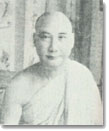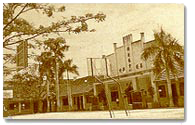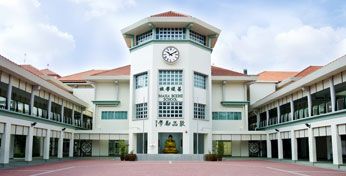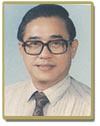History | 菩提校史
History
In 1946, Rev. Chee Hong of Leng Feng Bodhi Institute, an ardent promoter of Buddhist education, delegated Miss Pitt Chin Hui and others, aided by Buddhist believers, to undertake the establishing of Maha Bodhi School. A shophouse at No. 743, Geylang Road became a temporary school building with about 40 pupils. On 12 January 1948, the school was officially declared open. The first principal was Sister Wong Loon Soo.
菩提校史
1946 年,积极倡导佛教教育的灵峰菩提学院慈航法师委托毕俊辉女士等人,在佛教信徒的支持下,开展搭建菩提学校。位于芽笼路 743 号的一间店屋成为了一所临时学校校舍,约有40名学生。1948
年 1 月 12 日,学校正式开学。学校的首任校长由王弄书居士担任。

|
||
|---|---|---|
|
Reverend Chee Hong |
||
The Beginning
In 1950, Sister Wong left Singapore and went back to Penang. Miss
Pitt then took over as principal. Though the school had no proper
facilities, the school management committee worked hard to keep it running.
The pupil enrolment increased and the school progressed steadily. Subsequently,
the school management committee, decided to place the sponsorship of the
school under the Singapore Buddhist Federation for further development.
Mr Lee Choon Seng, Chairman of the Singapore Buddhist Federation formed
a school building committee to raise funds for the development of the school.

No. 743, Geylang Road – The first Maha Bodhi School in 1948
1948年, 第 一 所菩提学校设立于芽笼路743号。
开始
1950年,王弄书居士离开新加坡,回到槟城。毕俊辉女士接掌校长一职。虽然学校没有适当的设施,但学校董事会还是努力不懈地维持学校的运作。学生人数增加,学校稳步发展。后来,学校董事会决定把赞助学校的事宜交由新加坡佛教总会负责,以便学校能进一步发展。新加坡佛教总会主席李俊承先生成立建校委员会,为学校的发展筹款。
The Original School
In the same year, the site at 50, Lorong 34, Geylang, was acquired. On 21 January 1951, Rev. Yin Poon laid the foundation stone and construction work started. In July 1951, the pupils moved from the shophouse into the new building. The new school was officially declared open by the then British High Commissioner, Mr Malcolm MacDonald, on 1 December 1951. In 1957, the school was given grant-in-aid and it became a Government-aided school.
缘起
在同一年里,位于芽笼 34 巷 50 号的校址被征用。1951 年 1 月 21 日,演本法师为学校奠基并开始施工。1951 年 7 月,学生们正式从店屋搬入新校舍。1951 年 12 月 1 日,时任英国驻东南亚高级专员马尔科姆·麦克唐纳(Malcolm MacDonald)先生宣布新校正式启用。1957 年,学校获得政府津贴,成为一所政府辅助学校。

|
||
|---|---|---|
|
Former Maha Bodhi School building at Lor 34, Geylang |
||
|
菩提学校的原校舍位于芽笼 34 巷 |
||
The Demand
Over the years, the enrolment of pupils increased tremendously from a mere 40 to 1300 and the teaching staff from 4 to 40 by 1966. The increasing enrolment soon made the number of classrooms insufficient. Rev. Hong Choon, Chairman of the Singapore Buddhist Federation, Rev. Chan Khye, Secretary-General, and members of the school management committee undertook to extend the school building. The middle part of the school building was developed into a five-storey building, which included a spacious hall and more rooms. The extension cost amounted to $800,000.
扩建
1966 年,学生人数从 40 人激增到 1300人,教职员工也从 4 人增加到 40 人。入学人数的激增导致教室数量不足。因此,新加坡佛教总会主席宏船法师、秘书长常凯法师和学校管理委员会成员决定扩建校舍。校舍的中间部分扩建为五层楼,包括一个宽敞的大厅和更多的教室。扩建工程耗资 80 万元。
The Modern Building
On 20 December 1970, the extension was officially declared open by the then Parliamentary Secretary, Ministry of National Development, Mr Ho Cheng Choon. In the same year, the school became an integrated school, with classes for Chinese and English streams.
现代化教学楼
1970 年 12 月 20 日,时任国家发展部政务次长何振春先生为扩建后的校舍开幕。同年,学校成为一所中英混合学校,开设了中文班和英文班。

|
||
|---|---|---|
|
The new five-storey building at Lorong 34 in 1970s |
||
|
五层的新校舍在20 世纪 70 年代位于芽笼 34 巷 |
||
The First Principal
In 1971, Miss Pitt Chin Hui, the principal, retired after a successful term in office for 20 years. Mr Foo Soo Luang took over as principal. Mr Foo, like his predecessor, put special emphasis on bilingualism. In 1973, he encouraged the first batch of 50 Primary 6 Chinese- medium pupils to take the PSLE in the English-medium. All of them passed with very good grades.
首任校长
1971 年,校长毕俊辉女士在成功任职 20 年后退休。符书銮先生接任校长一职。符先生与前任校长一样,特别重视双语教学。1973 年,他鼓励首批 50 名受中文教育的小学六年级学生参加以英语为母语的 PSLE 考试。所有学生都以优异的成绩通过了考试

|
||
|
Miss Pitt Chin Hui |
The Achievement
In 1974, the Ministry of Education specially commended the school on this achievement. Maha Bodhi School was then named as one of the top ten schools which scored the highest marks in the English Language. The attempt proved that the pupils could do well in both languages, i.e. Chinese and English. At the same time, the school also started a wide range of extra curricular activities such as the brass band, lion dance, choir and art classes. These were aimed at enhancing the development of the physical well-being and nurturing the artistic talents of the pupils.
成就
1974 年,教育部特别表彰了学校的这一项成就。当时,菩提学校获评为英文成绩最高的十所学校之一。这次的尝试证明,学生们在中英文两种语言方面都能取得好成绩。与此同时,学校还开设了更多的课外活动,如铜管乐队、舞狮、合唱团和艺术班。这些活动旨在促进学生的身心发展,以及培养他们的艺术才能。
The Recognition
In 1985, the school became a full English-medium school. In 1990, it became a Special Assistance Plan (SAP) school which laid emphasis on the learning of English and Chinese and the inculcation of Asian moral values in the pupils. The school continued to perform well. From 1977 to 2015, the school produced eleven Prime Minister’s Book Prize winners, an annual award for outstanding bilingual pupils on the basis of excellent PSLE results.
特选学校
1985 年,学校成为一所全英语授课学校。1990 年,该校成为特选辅助计划(SAP)学校,重点学习英文和中文,并向学生灌输亚洲道德价值观。学校继续保持良好的办学业绩。从 1977 年到 2015 年,该校共培养出 11 名总理书籍奖得主,该奖项每年颁发给在 PSLE 考试中取得优异成绩的优秀双语学生。
The Next Millennium
In 1991, the Singapore Buddhist Federation, under the chairmanship of Ven Sek Yiu Torn, passed a resolution at the Annual General Meeting accepting the Government’s offer of a new site of 1.8 ha, at Ubi Avenue 1, in exchange for the land at Lorong 34, Geylang, under the “Quid Pro Quo Exchange” Scheme. The Singapore Buddhist Federation undertook to construct a new building to provide pupils with the latest equipment and facilities.
The cost of the new school building, together with its facilities, came to almost 20 million Singapore dollars. The pupils and staff moved into the new building in November 1995. It is well equipped with modern facilities such as an innovation centre, two music rooms, a band room, two computer laboratories, an audio-visual theatre and a state of the art video editing studio.

Today, Maha Bodhi School is one of the more well-known schools in Singapore.
With the start of the PERI (Primary School Education Review and Implementation) upgrading works in 2015, the school will enter a new phase of development, with the addition of enhanced infrastructure that supports the delivery of holistic education. The new school facilities will support differentiated teaching approaches, enabling our students to benefit from an enhanced learning environment.
下一个千年
1991 年,在新加坡佛教总会在主席优昙法师(Ven Sek Yiu Torn)的领导下,常年大会上议决,接受政府根据 “以地换地”计划提供的 1.8 公顷新校址(乌美一道 ),以交换芽笼34巷的土地。新加坡佛教总会承诺建造一座新校舍,为学生提供最新的设备和设施。
新校舍及其设施的造价将近 2000 万元。1995 年 11 月,学生和教职员工迁入新校舍。新校舍具备完善的现代化设施,如创新中心、两间音乐室、一间乐队室、两间电脑室、一间视听剧场和一间先进的视频编辑室。
如今,菩提学校已成为新加坡的名校之一。
随着2015年小学教育检讨及执行(PERI)升级工程的启动,学校将进入新的发展阶段,为学生提供全面教育。翻新工作完善了学校措施,让老师更有效地开展差异化教学,使我们的学生能够从更好的学习环境中受益。
Mr Foo Soo Luang 符书銮先生

Mr Foo Soo Luang retired in October 1996 after serving the school for 25 years as its principal. Taking on the task of the principalship was Mr Chew Chong Theng who left the school at the end of 2002. Mr Foo Chee Meng then became the next principal of the school from end 2002 to 2004. Mrs Lim Bee Lay who was then the vice-principal assumed duties as Principal from 2005-2013. Mrs Elaine Quek took over the reins as the Principal from 2014 to 2021.
Under the current leadership of Mrs See Lai Kwan, the school will continue to strive for excellence in both the academic as well as the non-academic, particularly focusing on the school's distinctive niche areas such as Aesthetics (Learn for Life Programme) and Communication (Applied Learning Programme).
符书銮先生
符书銮先生在担任学校校长 25 年后,于 1996 年 10 月退休。周宗廷先生接任校长一职,并于 2002 年底卸任。随后,符致明先生于 2002 年年底至 2004 年担任该校的下一任校长。 2005-2013 年间,时任副校长的周美丽女士接任校长一职。2014 至 2021 年,林惠珉女士接任校长一职。
在现任校长邓丽君女士的领导下,学校将继续在学术和非学术方面精益求精,尤其是在学校的专项领域,如美学(终身学习计划)和有效沟通(应用学习项目).

